Besides macroscopic plants and animals, microbes are the major components of biological systems on this earth. Microbes are present everywhere – in soil, water, air, inside our bodies and that of other animals and plants.
They are present even at sites where no other life-form could possibly exist–sites such as deep inside the geysers (thermal vents) where the temperature may be as high as 100°C, deep in the soil, under the layers of snow several meters thick, and in highly acidic environments.
Microorganisms are generally single celled or unicellular in nature. Microbes are diverse–protozoa, bacteria, fungi and microscopic plants, viruses, viroids and also prions that are proteinaceous infectious agents. Some of the microbes are shown in figures.
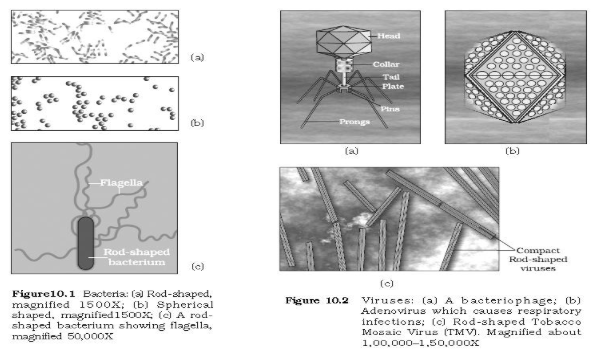
- Bacteria : (a) Rod – shaped, magnified 1500 X; (b) Spherical shaped, magnified 1500 X; (c) A rod shaped bacterium showing flagella, magnified 50,000 X
- Viruses : (a) A bacteriophage; (b) Adenovirus which causes respiratory infections; (c) Rod shaped Tobacco mosaic Virus (TMV). Magnified about 1,00,000 – 1,50,000X
Microbes like bacteria and many fungi can be grown on nutritive media to form colonies that can be seen with the naked eyes. Such cultures are useful in studies of micro-organisms.
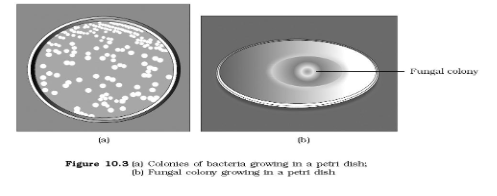
- Colonies of bacteria growing in a petri dish;
- Fungal colony growing in a petri dish
Microbes cause a large number of diseases in human beings. They also cause diseases in animals and plants. Several microbes are useful to man in diverse ways. Some of the most important contributions of microbes to human welfare are discussed in this chapter.
Microbes in Household Products
We use microbes or products derived from them every day.
Curd: A common example is the production of curd from milk. Micro-organisms such as Lactobacillus and others commonly called lactic acid bacteria (LAB) grow in milk and convert it to curd. During growth, the LAB produce acids that coagulate and partially digest the milk proteins. A small amount of curd added to the fresh milk as inoculum or starter contain millions of LAB, which at suitable temperatures multiply, thus converting milk to curd, which also improves its nutritional quality by increasing vitamin B12. In our stomach too, the LAB play very beneficial role in checking disease causing microbes.
Yoghurt: It is fermented milk. It is made from milk, skimmed milk or flavoured milk.
The fermentation is carried out byStreptococcussalivarius sub sppthermophilus andLactobacillus dulbruckii sub sppbulgaricus together at a level of 2% by volume. These bacteria are called lactic acid bacteria (LAB) because they convert milk sugar lactose into lactic acid. The LAB also improves its nutritional quality by increasing vitamin B12.
PH decrease from a level of 6.3 - 6.5 (milk) to 4.6 - 4.7 during the fermentation process. The flavour in yoghurt is due to acetaldehyde which is about 23 - 41 mg/kg. Both the organisms are lacking in alcohol dehydrogenase and produce acetaldehyde from glucose portion of lactose via pyruvate and due to the action of enzyme threonine aldolase.
Bread: The dough, which is used for making foods such as dosa and idli is also fermented by bacteria. The puffed-up appearance of dough is due to the production of CO2 gas. Similarly the dough, which is used for making bread, is fermented using baker’s yeast (Saccharomyces cerevisiae).
Drink: A number of traditional drinks and foods are also made by fermentation by the microbes. ‘Toddy’, a traditional drink of some parts of southern India is made by fermenting sap from palms using yeast. Fenny is made by fermenting cashewnuts. Sake is prepared by fermenting rice using fungus Aspergillus in Japan.
Microbes are also used to ferment fish, soyabean and bamboo shoots to make foods. Tempeh in Indonesia, Tofu in Japan and Sufu in China are fermented foods made from soyabean.
Cheese: Cheese, is one of the oldest food items in which microbes were used. Different varieties of cheese are known by their characteristic texture, flavour and taste. The specificity comes from the microbes used. For example, the large holes in ‘Swiss cheese’ are due to production of a large amount of CO2 by a bacterium named Propionibacteriumsharmanii. The ‘Roquefort cheese’ are ripened by growing a specific fungi Penicillium roquefortii on them, which gives them a particular flavour.
Camembert cheese or soft cheese (moisture content more then 50%) is prepared by using the inoculum ofPenicillium camemberti.
Microbes in Industrial Product
Even in industry, microbes are used to synthesise a number of products valuable to human beings. Beverages and antibiotics are some examples. Production on an industrial scale, requires growing microbes in very large vessels called fermentors.
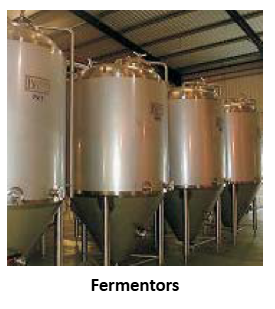
The main function of fermentation is to provide a controlled environment for growth of a microorganism to obtain a desired product.
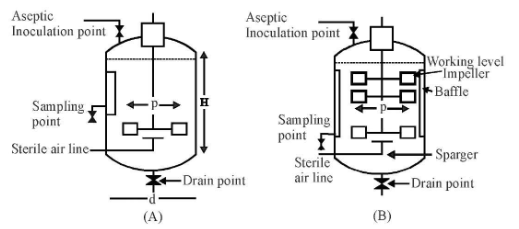
Different parts of fermentor (diagramatic, A) and a fermentor with multiblade impeller (B)
Fermantation Process
- Batch process: In this process a large volume of nutrient medium (with volumes as large as 2,25000 litres) is inoculated and allowed to proceed until maximum yield has been obtained.
- Continuous process: The fresh medium is added either continuously or intermittently accompanied by corresponding continuous or intermittent withdrawal of portion of a medium with the fermented product.
Fermented Beverages
Microbes especially yeasts have been used from time immemorial for the production of beverages like wine, beer, whisky, brandy or rum. For this purpose the same yeast Saccharomyces cerevisiaeused for bread-making and commonly called brewer’s yeast, is used for fermenting malted cereals and fruit juices, to produce ethanol. Often yeast is added in immobilized state in calcium alginate beads. Depending on the type of the raw material used for fermentation and the type of processing (with or without distillation) different types of alcoholic drinks are obtained. The nutrient medium is barley for beer, rye for gin, potato for vodka, molasses for rum, cereals for whisky and fruit juices for wines and brandy. Wine and beer are produced without distillation whereas whisky, brandy and rum are produced by distillation of the fermented broth.
The photograph of a fermentation plant is shown in Figure
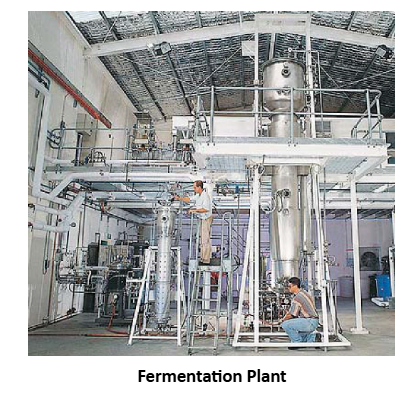
Antibiotics
Antibiotics produced by microbes are regarded as one of the most significant discoveries of the twentieth century and have greatly contributed towards the welfare of the human society.
Anti is a Greek word that means ‘against’, and biomeans ‘life’, together they mean ‘against life’ (in the context of disease causing organisms); whereas with reference to human beings, they are ‘pro life’ and not against.
Antibiotics are chemical substances, which are produced by some microbes and can kill or retard the growth of other (disease-causing) microbes.
Penicillin was the first antibiotic to be discovered, and it was a chance discovery. Alexander Flemming while working on Staphylococcibacteria, once observed a mould growing in one of his unwashed culture plates around which Staphylococcicould not grow. He found out that it was due to a chemical produced by the mould and he named it Penicillin after the mould Penicillium notatum.However, its full potential as an effective antibiotic was established much later by Ernest Chain and Howard Florey. This antibiotic was extensively used to treat American soldiers wounded in World War II. Fleming, Chain and Florey were awarded the Nobel Prize in 1945, for this discovery.
Streptomyces griseus produces more than 41 antibiotics while Bacillussubtilis gives about 60 antibiotics. Among eubacteria most antibiotics are got from Bacillus (70%) and Psuedomonas (30%). Common antibiotic from lichens is usnic acid. Many fungi also yield antibiotics.
Table :Some Clinically Important Antibiotics.
|
S.No |
Antibiotic |
Producer Organism |
Activity Aginst |
Mode of Action (inhibit) |
|
1. |
Penicillin |
Penicillium chrysogenum |
G + ve bacteria |
Cell wall Synthesis |
|
2. |
Cephalosporin |
Cephalosporium acremonium |
Broad spectrum |
Cell wall Synthesis |
|
3. |
Fumagillin |
Aspergillus fumigatus |
________ |
Cell wall Synthesis |
|
4. |
Griseofulvin |
Pencillium groseofulvum |
Dermatophitic fungi |
Microtubule formation |
|
5. |
Bacitracin |
Bacillus subtilis |
G + ve bacteria |
Cell wall synthesis |
|
6. |
Polymyxin B |
B. Polymyxa |
G - ve bacteria |
Cell membrane |
|
7. |
Amphotericin B |
Streptomyces nodosus |
Fungi |
Cell membrane |
|
8. |
Erythromycin |
Streptomyces erythreus |
G + ve bacteria |
Protein synthesis |
|
9. |
Neomycin |
S. fradiae |
Broad spectrum |
Protein synthesis |
|
10. |
Streptomycin |
S. griseus |
G - ve bacterium |
Protein synthesis |
|
11. |
Tetracycline |
S. ramosus |
Broad spectrum |
Protein synthesis (oxytracycline or Terramycin) |
|
S.No |
Antibiotic |
Producer Organism |
Activity Aginst |
Mode of Action (inhibit) |
|
12. |
Vancomycin |
S. orientalis |
G + ve Bacteria |
Protein synthesis |
|
13. |
Gentamycin |
Micromonospora purpurea |
Broad spectrum |
Protein synthesis |
|
14. |
Rifamycin |
S. mediferranei |
Tuberculosis |
Protein synthesis |
|
15. |
Gramicidin |
Bacillus brevis |
Deteriorates |
Cell membrane |
|
16. |
Colymycin |
B. colistinus |
Deteriorates |
Cell membrane |
|
17. |
Chloamphenicol |
S. venezulae |
________ |
Protein synthesis |
|
18. |
Novobiocin |
S. niveus and S. spheroids |
________ |
Inhibit DNA polymerization |
- Chloramphenicol inhibits the activity of peptidyl transferase after binding to 50S subunit of bacterial ribosome during protein synthesis. It is bacteriostatic i.e after removal of drug the effect is soon reversed. However, its effect in eukaryotes is the same as in prokaryotes.
- Tetracyclines prevent the binding of aminoacyl tRNA to the A site of 30S ribosome. Moreover it can bind to several sites of both 30S and 50S subunits.
- Cycloheximide inhibits protein synthesis in eukaryotes but not in prokaryotes. It interferes in the activity of ribosome present in cytoplasm but not in mitochondria by binding with 80 S subunits and preventing the movement of mRNA.
- Puromycin binds to peptide with the C-terminus of growing polypeptide and results in premature termination of polypeptide chain. It interacts with the P site of ribosome but not with A site. It works equally well on 70S and 80S ribosomes.
- After Penicillin, other antibiotics were also purified from other microbes. Antibiotics have greatly improved our capacity to treat deadly diseases such as plague, whooping cough (kali khansi ), diphtheria (galghotu) and leprosy (kusht rog), which used to kill millions all over the globe. Today, we cannot imagine a world without antibiotics.
Chemicals, Enzymes and other Bioactive Molecules
Microbes are also used for commercial and industrial production of certain chemicals like organic acids, alcohols and enzymes. Examples of acid producers are Aspergillus niger(a fungus) of citric acid, Acetobacter aceti(a bacterium) of acetic acid; Clostridium butylicum(a bacterium) of butyric acid and Lactobacillus(a bacterium) of lactic acid. Yeast (Saccharomyces cerevisiae) is used for commercial production of ethanol.
- Microbes are also used for production of enzymes. Lipases are used in detergent formulations and are helpful in removing oily stains from the laundry. Bottled fruit juices bought from the market are clearer as compared to those made at home. This is because the bottled juices are clarified by the use of pectinases and proteases. Lactases prevent crystal formation in icecreams and cheese. Rennet obtained from calf stomach is used to prepare cheese.
- Streptokinase produced by the bacterium Streptococcusand modified by genetic engineering is used as a ‘clot buster’ for removing clots from the blood vessels of patients who have undergone myocardial infraction leading to heart attack.
- Another bioactive molecule, cyclosporinA, that is used as an immunosuppressive agent in organ-transplant patients, is produced by the fungus Trichoderma polysporum. Statins produced by the yeast Monascus purpureushave been commercialised as blood-cholesterol lowering agents. It acts by competitively inhibiting the enzyme responsible for synthesis of cholesterol.
Single Cell Protein
Microorganisms eg. bacteria (Methylophilus methylotrophus),Cyanobacteria (Spirulina), yeast(Saccharomyces cereviseae, Candida utilis etc.),filamentous fungi (Fusarium graminearum, Chaetomium cellulolyticum), algae(Chlorella, Scandesmus etc.)which can be cultured on a commercial scale in a source or as animal feed are called single cell proteins (SCP).
- The biomass obtained from unicellular microorganism is considered as SCP.
- The SCP is rich in high quality protein and poor in fat content. The microoganisms used in the production of SCP are very fast growing and produce large amount SCP from relatively very small area. SCP are grown on agricultural and organic wastes thus playing a role in pollution management.
Microbes in Sewage Treatment
Large quantities of waste water are generated everyday in cities and towns. A major component of this waste water is human excreta. This municipal waste-water is also called sewage. It contains large amounts of organic matter and microbes. Many of which are pathogenic. This cannot be discharged into natural water bodies like rivers and streams directly. Before disposal, hence, sewage is treated in sewage treatment plants (STPs) to make it less polluting. Treatment of waste water is done by the heterotrophic microbes naturally present in the sewage. This treatment is carried out in two stages:
Primary treatment : These treatment steps basically involve physical removal of particles – large and small – from the sewage through filtration and sedimentation. These are removed in stages; initially, floating debris is removed by sequential filtration. Then the grit (soil and small pebbles) are removed by sedimentation. All solids that settle form the primary sludge, and the supernatant forms the effluent. The effluent from the primary settling tank is taken for secondary treatment.
Secondary treatment or Biological treatment : The primary effluent is passed into large aeration tanks where it is constantly agitated mechanically and air is pumped into it. This allows vigorous growth of useful aerobic microbes into flocs (masses of bacteria associated with fungal filaments to form mesh like structures).
- While growing, these microbes consume the major part of the organic matter in the effluent. This significantly reduces the BOD (biochemical oxygen demand) of the effluent. BOD refers to the amount of the oxygen that would be consumed if all the organic matter in one litre of water were oxidised by bacteria.
- The sewage water is treated till the BOD is reduced. The BOD test measures the rate of uptake of oxygen by micro-organisms in a sample of water and thus, indirectly, BOD is a measure of the organic matter present in the water. The greater the BOD of waste water, more is its polluting potential.
- Once the BOD of sewage or waste water is reduced significantly, the effluent is then passed into a settling tank where the bacterial ‘flocs’ are allowed to sediment. This sediment is called activated sludge. A small part of the activated sludge is pumped back into the aeration tank to serve as the inoculum. The remaining major part of the sludge is pumped into large tanks called anaerobic sludge digesters. Here, other kinds of bacteria, which grow anaerobically, digest the bacteria and the fungi in the sludge. During this digestion, bacteria produce a mixture of gases such as methane, hydrogen sulphide and carbon dioxide. These gases form biogas and can be used as source of energy as it is inflammable. The effluent from the secondary treatment plant is generally released into natural water bodies like rivers and streams. An aerial view of such a plant is shown in Figure.
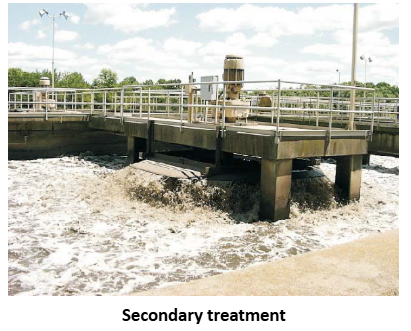
Tertiary treatment: Tertiary treatment is aimed to remove nonbiodegradable organic materials, heavy metals, and minerals. The salt of nitrogen and phosphorus must be removed because they cause eutrophication. Finally the sewage effluent is subjected to chemical treatment for disinfection before releasing it into natural water bodies.
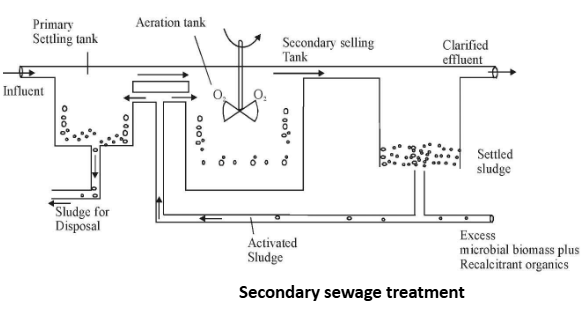
Microbes play a major role in treating millions of gallons of waste water everyday across the globe. This methodology has been practiced for more than a century now, in almost all parts of the world. Till date, no manmade technology has been able to rival the microbial treatment of sewage.
Due to increasing urbanisation, sewage is being produced in much larger quantities than ever before. However the number of sewage treatment plants has not increased enough to treat such large quantities. So the untreated sewage is often discharged directly into rivers leading to their pollution and increase in water-borne diseases.
The Ministry of Environment and Forests has initiated Ganga Action Plan and Yamuna Action Plan to save these major rivers of our country from pollution. Under these plans, it is proposed to build a large number of sewage treatment plants so that only treated sewage may be discharged in the rivers.
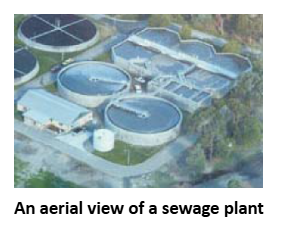
Microbes in Production of Biogas
Biogas is a mixture of gases (containing predominantly methane) produced by the microbial activity and which may be used as fuel. Microbes produce different types of gaseous end-products during growth and metabolism.
The type of the gas produced depends upon the microbes and the organic substrates they utilise. In the examples cited in relation to fermentation of dough, cheese making and production of beverages, the main gas produced was CO2. However, certain bacteria, which grow anaerobically on cellulosic material, produce large amount of methane along with CO2 and H2. These bacteria are collectively called methanogens, and one such common bacterium is Methanobacterium. These bacteria are commonly found in the anaerobic sludge during sewage treatment. These bacteria are also present in the rumen (a part of stomach) of cattle. A lot of cellulosic material present in the food of cattle is also present in the rumen.
In rumen, these bacteria help in the breakdown of cellulose and play an important role in the nutrition of cattle. Thus, the excreta (dung) of cattle, commonly called gobar, is rich in these bacteria. Dung can be used for generation of biogas, commonly called gobar gas.
The biogas plant consists of a concrete tank (10-15 feet deep) in which bio-wastes are collected and a slurry of dung is fed. A floating cover is placed over the slurry, which keeps on rising as the gas is produced in the tank due to the microbial activity. The biogas plant has an outlet, which is connected to a pipe to supply biogas to nearby houses. The spent slurry is removed through another outlet and may be used as fertiliser.
Cattle dung is available in large quantities in rural areas where cattle are used for a variety of purposes. So biogas plants are more often build in rural areas. The biogas thus produced is used for cooking and lighting. The picture of a biogas plant is shown in figure.
The technology of biogas production was developed in India mainly due to the efforts of Indian Agricultural Research Institute (IARI) and Khadi and Village Industries Commission (KVIC).
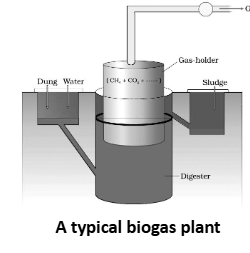
Microbes as Biocontrols Agents
Biocontrol refers to the use of biological methods for controlling plant diseases and pests. In modern society, these problems have been tackled increasingly by the use of chemicals –insecticides and pesticides. These chemicals are toxic and extremely harmful, to human beings and animals alike, and have been polluting our environment (soil, ground water), fruits, vegetables and crop plants. Our soil is also polluted through our use of weedicides to remove weeds.
Biological control of pests and diseases:
In agriculture, there is a method of controlling pests that relies on natural predation rather than introduced chemicals.
A key belief of the organic farmer is that biodiversity furthers health. The more variety a landscape has, the more sustainable it is. The organic farmer, therefore, works to create a system where the insects that are sometimes called pests are not eradicated, but instead are kept at manageable levels by a complex system of checks and balances within a living and vibrant ecosystem.
Contrary to the ‘conventional’ farming practices which often use chemical methods to kill both useful and harmful life forms indiscriminately, this is a holistic approach that seeks to develop an understanding of the webs of interaction between the myriad of organisms that constitute the field fauna and flora.
The organic farmer holds the view that the eradication of the creatures that are often described as pests is not only possible, but also undesirable, for without them the beneficial predatory and parasitic insects which depend upon them as food or hosts would not be able to survive. Thus, the use of biocontrol measures will greatly reduce our dependence on toxic chemicals and pesticides.
An important part of the biological farming approach is to become familiar with the various life forms that inhabit the field, predators as well as pests, and also their life cycles, patterns of feeding and the habitats that they prefer. This will help develop appropriate means of biocontrol.
The very familiar beetle with red and black markings – the Ladybird, and Dragonflies are useful to get rid of aphids and mosquitoes, respectively.
An example of microbial biocontrol agents that can be introduced in order to control butterfly caterpillars is the bacteria Bacillus thuringiensis(often written as Bt ). These are available in sachets as dried spores which are mixed with water and sprayed onto vulnerable plants such as Brassica and fruit trees, where these are eaten by the insect larvae.
In the gut of the larvae, the toxin is released and the larvae get killed. The bacterial disease will kill the caterpillars, but leave other insects unharmed. Because of the development of methods of genetic engineering in the last decade or so, the scientists have introduced B. thuringiensis toxin genes into plants. Such plants are resistant to attack by insect pests. Bt-cotton is one such example, which is being cultivated in some states of our country.
- A biological control being developed for use in the treatment of plant disease is the fungus Trichoderma. T
- richoderma species are free-living fungi that are very common in the root ecosystems. They are effective biocontrol agents of several plant pathogens.
Baculoviruses are pathogens that attack insects and other arthropods. The majority of baculoviruses used as biological control agents are in the genus Nucleopolyhedrovirus. These viruses are excellent candidates for species-specific, narrow spectrum insecticidal applications. They have been shown to have no negative impacts on plants, mammals, birds, fish or even on non-target insects. This is especially desirable when beneficial insects are being conserved to aid in an overall integrated pest management (IPM) programme, or when an ecologically sensitive area is being treated.
Biopesticides
Biopesticides are pesticides of biological origin.
Bioherbicides and Biological of Weeds
Certain crop plants do not allow the weeds to grow nearby. They are called smoother crops, e.g. Barley, Rye, Sorghum, Millet, Sweet clover, Alfalfa. Another way of weed control is the introduction of specific insects which feed on the weeds. However, the herbivore has to be carefully evaluated so that it may not switch over to the useful plants in case the weeds get eliminated. Extensive growth of Opuntia in India and Australia was checked through the introduction of its natural herbivore, cochineal insect (Cactoblastosiscactorum). Growth of Hypericum perforatum weed was controlled by introduction of Chrysolina beetles in USA.
- The first bioherbicide happened to be mycoherbicide. It was elaborated in 1981. The herbicide is Phytophthora palmivora. The fungus does not allow the milkweed vine to grow in Citrus orchards.
- Fungal spores like Devine and Collego are used as weedicides.
Bioinsecticides
Insecticides, and for that matter all pesticides, should be specific for target organisms, nontoxic to others, nonpersistent and biodegradable.
Predators: Destructive insects or plant pests can be brought under control through introduction of their natural predators. The predators should be specific and unable to harm the useful insects. Introduction of ladybugs (Lady Bird Beetles) and Praying Mantis has been successful in combating scale insects or aphids which feed on plant sap.
Intercropping: This keeps the population of insects at low level. In intercropping the crop favoured by particular insect pest is grown along with another which is normally repellent to the pest.
Insect hormones: Two types of insect hormones are used for controlling pests.
Sex pheromones are used in two ways;
- Pheromone Traps. Traps containing hollow cylinders coated from inside with a sticky substance and sex pheromones are kept at different places in the fields. The male insects fly into the traps and get immobilised. As the males become unavailable for mating, the population of the insect will decline rapidly. Gypsy moth has been controlled by this technique.
- Confusion Technique. Small pieces of unwettable paper containing sex pheromone of a particular insect are dropped over the fields. The males will not be able to locate the females because the pheromone is spread everywhere.
Natural Insecticides. Natural insecticides are specific in nature, nonpersistent, nontoxic to higher forms and easily biodegradable. A number of natural insecticides are available.
The common ones include
- Azadirachtin from Margosa or Neem - (Azadirachta indica).
- Pyrethrum. It is an insecticide which is obtained from the inflorescence of Chrysanthemum.
- Thurioside. It is a toxin produced by bacterium Bacillus thuringiensis
- Transgenic Plants. They are crop plants which are modified through genetic engineering to develop natural resistance to insects. Transgenic Tomato has been developed which is resistant to hornworm larvae.
Squill: is a raticide got from sea onion Ureginea maritima.
Nicotine sulphate: is one of the most toxic insecticides. It is obtained from Nicotiana species.
Rotenone: is powerful insecticide harmless to warm blooded animals and got from roots of Derris elliptica.
Microbes as Biofertilisers
Environmental pollution is a major cause of concern. The use of the chemical fertilisers to meet the ever-increasing demand of agricultural produce has contributed significantly to this pollution. There are problems associated with the overuse of chemical fertilisers and there is a large pressure to switch to organic farming and use biofertilisers.
Biofertilisers are organisms that enrich the nutrient quality of the soil. The main sources of biofertilisers are bacteria, fungi and cyanobacteria. Nodules on the roots of leguminous plants are formed by the symbiotic association of Rhizobium. These bacteria fix atmospheric nitrogen into organic forms, which is used by the plant as nutrient.
Other bacteria can fix atmospheric nitrogen while free-living in the soil (examples Azospirillumand Azotobacter), thus enriching the nitrogen content of the soil. Fern Azolla is popularly grown in paddy fields as biofertiliser as it has symbiotic association with BGA Anabaena in its roots making it a rich source of nitrogen. BGA Aulosira fertilisiana is grown as biofertiliser in paddy fields.
Fungi are also known to form symbiotic associations with plants (mycorrhiza). Many members of the genus Glomusform mycorrhiza. The fungal symbiont in these associations
absorbs phosphorus from soil and passes it to the plant. Plants having such associations show other benefits also, such as resistance to root-borne pathogens, tolerance to salinity and drought, and an overall increase in plant growth and development.
Ectomycorrhiza: They perform several functions for the plant -
- Absorption of water
- Solubilisation of organic matter of the soil humus, release of inorganic nutrients, absorption and their transfer to root.
- Direct absorption of minerals from the soil over a large area and sending over the same to the root. Plants with ectomycorrhiza are known to absorb 2-3 times more of nitrogen, phosphorus, postassium and calcium,
- The fungus secretes antimicrobial substances which protect the young roots from attack of pathogens. Ectomycorrhiza occurs in the trees like Eucalyptus, Oak (Quercus), Peach, Pine, etc.
Endomycorrihiza: Endomycorrhiza is also called VAM or vesicular-arbuscular mycorrhiza. The major benefits of VAM to the plant is the supply of inorganic nutrients as well as enhanced water absorption. Phosphate which is mostly present in the unavailable form in the soil, becomes abundantly available to the plant. Besides, the fungus provides various growth promoting substances. Consequently, plants having endomycorrihizae show more vigorous growth.
Cyanobacteria are autotrophic microbes widely distributed in aquatic and terrestrial environments many of which can fix atmospheric nitrogen, e.g. Anabaena, Nostoc, Oscillatoria, etc. In paddy fields, cyanobacteria serve as an important biofertiliser. Blue green algae also add organic matter to the soil and increase its fertility. Currently, in our country, a number of biofertilisers are available commercially in the market and farmers use these regularly in their fields to replenish soil nutrients and to reduce dependence on chemical fertilisers.
Economic importance of important bacteria:
|
S.No |
Products/Processes |
Bacteria |
| 1 |
Preparation of acetone-butanol |
Clostridium acetobutylicum |
| 2 |
Preparation of acetic acid/vinegar |
Acetobacter aceti |
| 3 |
Preparation of lactic acid |
Lactobacillus delbruecki |
| 4 |
Retting of fibres |
Clostridium butyricum |
| 5 |
Curing of tobacco |
Bacillus megatherium |
| 6 |
Curing of tea |
Mycococcus condisans Bacillus megatherium |
| 7 |
Preparation of amino acid threonine |
Escherichia coli |
| 8 |
Decomposition of DDT |
Aerobacter aerogenes |
| 9 |
Decomposition of oil spills |
Psuedomonas putida(superbug) |
| 10 |
Genetic engineering |
Agrobacterium tumefaciens Escherichia coli |
| 11 |
Vitamin B2 (Riboflavin) |
Clostridium butylicum |
| 12 |
Vitamin B12 |
Propionibacterium shermanii |
| 13 |
SCP |
Methylophilus methylotropus |
Frequently Asked Questions
Microbes are microscopic living organisms like bacteria, fungi, protozoa, some algae, and viruses (acellular). They are found in soil, water, air, inside plants, animals, and even in extreme environments.
- Lactic Acid Bacteria (LAB) – Converts milk to curd, enhances nutritional value, prevents harmful bacteria in the gut.
- Yeast (Saccharomyces cerevisiae) – Used in baking (bread), brewing (beer, wine), and fermentation (toddy).
- Fermented foods – Idli, dosa, cheese, vinegar.
- Beverages – Saccharomyces cerevisiae for alcoholic drinks.
- Antibiotics – Penicillium notatum for penicillin.
- Organic acids – Citric acid (Aspergillus niger), Acetic acid (Acetobacter aceti), Butyric acid (Clostridium butyricum), Lactic acid (Lactobacillus).
- Enzymes – Streptokinase (clot buster), Lipase (detergents), Pectinase (clarifying fruit juices).
- Primary treatment – Removes large particles.
- Secondary treatment – Aerobic bacteria digest organic matter forming activated sludge.
- Anaerobic sludge digestion – Methanogens produce methane-rich biogas.
Methanogens like Methanobacterium decompose organic waste anaerobically to produce biogas, used for cooking and electricity generation.
- Bacteria – Rhizobium, Azotobacter, Azospirillum fix nitrogen.
- Cyanobacteria – Anabaena, Nostoc add nitrogen in paddy fields.
- Fungi – Mycorrhiza (Glomus species) help plants absorb water and nutrients.
- Bacillus thuringiensis (Bt) – Produces protein toxic to insect pests (used in Bt cotton).
- Trichoderma – Fungus against plant pathogens.
- Predators – Ladybird beetles and dragonflies control aphids and mosquitoes.
Bt cotton is genetically modified with the Bt toxin gene from Bacillus thuringiensis. The toxin kills bollworm larvae when they feed on plant parts.
Yes. Some microbes cause diseases in humans (Mycobacterium tuberculosis – TB), plants (Xanthomonas – citrus canker), and animals.
Because they improve soil fertility (biofertilizers), reduce dependence on chemical fertilizers, control pests naturally, and help in sustainable agriculture.